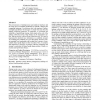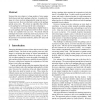63 search results - page 1 / 13 » Tracing garbage collection on highly parallel platforms |
IWMM
2010
Springer
13 years 9 months ago
2010
Springer
The pervasiveness of multiprocessor and multicore hardware and the rising level of available parallelism are radically changing the computing landscape. Can software deal with tom...
PODC
1997
ACM
13 years 9 months ago
1997
ACM
Systems that store objects at a large number of sites require fault-tolerant and timely garbage collection. A popular technique is to trace each site independently using inter-sit...
ASPLOS
2004
ACM
13 years 10 months ago
2004
ACM
Tracing garbage collectors traverse references from live program variables, transitively tracing out the closure of live objects. Memory accesses incurred during tracing are essen...
IWMM
2004
Springer
13 years 10 months ago
2004
Springer
Garbage-First is a server-style garbage collector, targeted for multi-processors with large memories, that meets a soft real-time goal with high probability, while achieving high ...
IWMM
1992
Springer
13 years 9 months ago
1992
Springer
Abstract. Automatic storage management is important in highly parallel programming environments where large numbers of objects and processes are being constantly created and discar...


